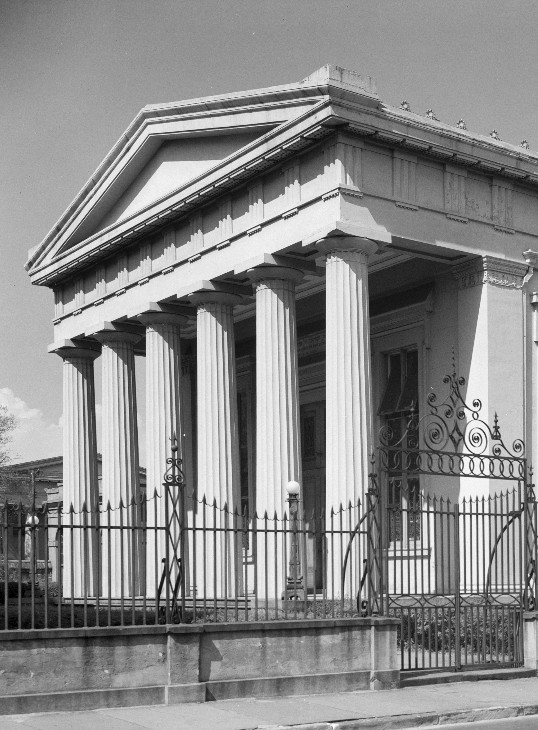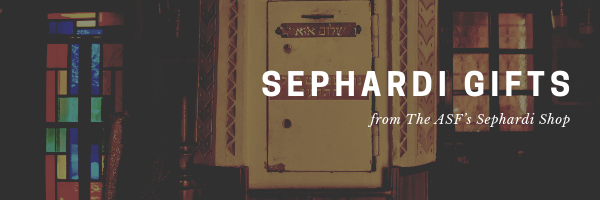In Honor of Distinguished ASF Board Member Bruce Slovin, a Brooklyn-born businessman and philanthropist, who combines a scholar’s sensibility for preserving and making accessible primary sources with an entrepreneur’s short attention span. In less than a decade, Bruce brought together five of the world’s leading Jewish institutions—the American Jewish Historical Society, American Sephardi Federation, Leo Baeck Institute, Yeshiva University Museum, and YIVO Institute for Jewish Research—to create a beautiful, 125,000 sq ft space for scholarly study and cultural activity in the heart of Manhattan. In less than two decades, Bruce propelled his creation, The Center for Jewish History, to become the preeminent “research, historical, and educational institution of the Jewish world, exploring the richness of Jewish life and letters, and showcasing the enormous contributions Jews have made to modern civilization.” Bruce is featured in the latest episode of WLIW’s “Treasures of New York.”
Click here to dedicate a future issue in honor or memory of a loved one
Subscribe ◊ Upcoming Events ◊ ASF Sephardi Shop ◊ Donate ◊ Sephardi Ideas Monthly ◊ ASF IJE ◊ ASF Sephardi House ◊ Archive
The Sephardi World Weekly is made possible by Daniel Yifrach, Rachel Sally, Professor Rifka Cook, Maria Gabriela Borrego Medina, Rachel Amar, Deborah Arellano, & ASF VP Gwen Zuares!
Don’t miss the latest Sephardi Ideas Monthly: “Two Jewish Songs, Ancient and Israeli”
Lincoln’s Sephardic Inspiration at Gettysburg
(Scan courtesy of The Marvin Weiner Catalogue of the Sabato Morais Ledger (University of Pennsylvania Libraries: Schoenberg Center for Electronic Text and Image), p. 22 / Image 40)
Pictured above is an excerpt of Rev. Dr. Sabato Morais’s sermon on Independence Day, 4 July/17 Tammuz, 1863. An avid abolitionist and proponent of Abraham Lincoln and the Patriot’s cause in the War of the Rebellion then ragging, the sermon Morais delivered at Philadelphia’s Mikveh Israel, was republished about a week later in New York’s The Jewish Messenger. From there Morais may “have made a lasting contribution to American rhetorical history” as his then-unique phraseology would subsequently appear, whether deliberately or coincidentally is unknowable, in Lincoln’s Gettysburg Address (see: Marc Saperstein’s “‘Four Score and Seven Years Ago’: A Jewish Connection”)
The excerpt reads: “I am not indifferent, my dear friends! to the event [the Declaration of Independence] , which four score and seven years ago, brought to this new world light and joy. I yield to none in the feelings of deep reverence for the sages and patriots that labored for its consummation. The principles enunciated in the document unfolded and first read in yonder hall, command still my highest admiration. But the more intently I gaze upon the bright past, the darker does the present appear to my vision.”
Thankfully, unlike the Jewish defenders at Jerusalem in 70 CE, the Union defenders repelled their attackers, the Confederate invaders of the North, at Gettysburg on 1-3 July, as Morais found out after his sermon.
To learn more about Mikveh Israel’s Hakham Rabbi Dr. Sabato Morais see: Sephardi Ideas Monthly’s “Continuity, not Rupture: Sabato Morais’s Sephardi Rabbinic Humanism in Victorian America” and “A Dream Deferred: The Andalusian-Italian Sephardi Tradition in America.”
~~~~~~~
“Jewish patriot joins South Carolina legislature, Jan. 11, 1775”
By Andrew Glass, Politico
The original Sephardic Kahal Kadosh Beth Elohim Synagogue, the second oldest synagogue in America, Charleston, South Carolina
(Photo courtesy of the Historic American Buildings Survey - Library of Congress)
Francis Salvador was a Sephardi Jew whose family emigrated from mainland England to the American colonies in the 18th century. On 11 January 1775, Salvador became the first Jew to be elected to an American colonial legislature, only to become the first Jewish soldier killed in the American War of Independence soon thereafter, when ambushed by Cherokees and British loyalists.
~~~~~~~
“Inaugurating NYC’s Mill Street Synagogue/Sexias Way”
ASF President David Dangoor, Mill Street Synagogue/Sexias Way Co-Naming Ceremony, 8 April 2019
(Photo courtesy of Zak Siraj)
The first synagogue in North America was located on Mill Street in lower Manhattan. Built in 1730 to serve Congregation Shearith Israel, the Spanish & Portuguese Synagogue’s Reverend, Gershom Mendes Seixas, preached persuasively on behalf of the principles of liberty and supported the Patriot's cause in the American War of Independence.
On 8 April 2019, 289 years to the day the synagogue was built, the Lower Manhattan Historical Association, the Sons of the Revolution in the State of New York, the American Sephardi Federation, the Temple of Universal Judaism, and the Jewish Learning Experience came together with 1st District New York City Council Member Margaret Chin to inaugurate the co-naming of South William Street as the Mill Street Synagogue/Seixas Way.
Ambassador John Loeb was also honored at the ceremony with the LMHA & Sons of the Revolution in the State of New York’s Religious Freedom Award.
Click here to watch the ceremony
~~~~~~~
Inaugural Omni-American Event: Combating Racism & Antisemitism Together
In 2021, the American Sephardi Federation, Combat Antisemitism Movement, and Jazz Leadership Project launched the Omni-American Future Project to combat racism and antisemitism together. The inaugural event honored Jazz at Lincoln Center’s Wynton Marsalis and U.S. Representative Ritchie Torres (NY-15). Marsalis said in his acceptance speech: “We are many, let us also be one, unified in our embrace of humanism and cultural excellence and democracy….” In receiving his award, Torres described how American elected officials “have an obligation to defend the core value that lies at the core of the American experience, which is diversity… Part of our commitment to promoting pluralism is fighting against extremism in every form, including antisemitism. And I worry about the creeping antisemitism here in the United States and elsewhere in the world which has taken the form of a delegitimization campaign against Israel….”
At two subsequent events in Harlem we honored Professor Danielle Allen and Coleman Hughes (2022) as well as Roy Niederhoffer and Emmet Cohen (2024).
See also: The Omni-American Future’s Sephardi Dimension, American Excellence: Jews and the Jazz Tradition, How Sephardi House Became My Sephardi Home and An Omni-American Story, and Introducing The Omni-American Review
~~~~~~~
Feature: Emma Lazarus, Irving Berlin, and “Miss Liberty”
Excerpt from the original The New Colossus, in Emma Lazarus’ notebook (p. 1), part of the permanent collection of The American Jewish Historical Society (AJHS)
America’s willingness to open her doors to immigrants from every corner of the globe has been unique in the annals of world history. This 4th of July, the American Sephardi Federation celebrates the vision of freedom that has moved millions to immigrate to America with Irving Berlin’s musical rendition of American Sephardi poet Emma Lazarus’ “The New Colossus,” the sonnet that adorns the foot of the Statue of Liberty. Berlin’s song, “Give Me Your Tired, Your Poor,” is taken from his 1949 musical, “Miss Liberty.” In this 2009 performance, Lazarus’ famous lines are sung by Sandy Patti, together with the Cincinnati Pops.
~~~~~~~
Bonus Feature: Jewish Spain in American Tongue: The Sephardic Return of Emma Lazarus
(Screenshot courtesy of The Jewish Broadcasting Service)
À propos Independence Day: watch ASF Broome & Allen Fellow Leonard Stein’s fascinating Young Sephardi Scholars Series lecture at The Center for Jewish History, co-sponsored by the American Jewish Historical Society and Leo Baeck Institute (LBI), on the life and work of American Sephardi poetess and patriot Emma Lazarus, whose iconic sonnet is inscribed upon the pedestal of the Statue of Liberty.
~~~~~~~
“Covenant and the American Founding”
Abolitionist William Lloyd Garrison’s banner featuring the Liberty Bell’s image and inscription (from Vayikra/Leviticus XXV:X): “Proclaim LIBERTY throughout all the Land unto all the Inhabitants thereof”
Boston, MA., 1843
(Photo courtesy of the Massachusetts Historical Society)
In 2017, Sephardi Ideas Monthly featured a series of articles on the political concept of “covenant” by Professor Daniel J. Elazar, a highly successful political theorist and the Founder and First President of both the American Sephardi Federation and Jerusalem Center for Public Affairs. In the series' third article, Professor Elazar begins with Abraham Lincoln’s “view of the American experience as being parallel to that of biblical Israel. If Americans were not the chosen people, they were at least, in his eyes, ‘an almost chosen people.’”
~~~~~~~
“Star Spangled Banner-based Syrian Sephardi Piyyut ”
Hebrew Text and Recording by Sephardic Pizmonim Project
Introduction by Eddie Ashkenazie, Sephardi World Weekly
Magen David Congregation, Brooklyn, NY
(Photo courtesy of At Home Studios)
Magen David Congregation was the first Syrian Sephardi synagogue built in Brooklyn. In honor of its 1921 inauguration, Rabbi Moses Ashear, who would serve as the hazzan of the Congregation until his death, composed a piyyut. Incorporating verses and terminology from the Tanach, the song begins by praising the actions of the committee who built the synagogue and then goes on to glorify the building and its importance for the community that would grow around it.
While other songs were written for the occasion, only this piyyut was set to the Star-Spangled Banner. The reason is unknown. Perhaps Rabbi Ashear, as an immigrant to the United States from Syria in the early 1900s, wished to celebrate the community finding success in America by synthesizing an aspect of the Syrian tradition (the composition of piyyutim) with the National Anthem. He may also have wished to situate this event within the context of America’s ideas and ideals, especially our rights to Thought, Worship, Speech, and Assembly, as codified in the Declaration of Independence and Constitution.
~~~~~~~
Please support the ASF with a generous, tax-deductible contribution so we can continue to cultivate and advocate, preserve and promote, as well as educate and empower!
~~~~~~~
Saving Monticello: The Levy Family’s Epic Quest to Rescue the House That Jefferson Built
By Marc Leepson
Saving Monticello offers the first complete post-Jefferson history of this American icon and reveals the amazing story of how one Sephardic Jewish family saved the house that became a family home to them for 89 years - longer than it ever was to the Jeffersons.
Commodore Uriah P. Levy discovered that Jefferson’s mansion had fallen into a miserable state of decay. Acquiring the ruined estate and committing his considerable resources to its renewal, Levy began what became a tumultuous nine-decade relationship between his family and Jefferson’s home. After passing from Levy control at the time of the commodore’s death, Monticello fell once more into hard times, cattle being housed on its first floor and grain in its once elegant upper rooms. Again, remarkably, a member of the Levy family came to the rescue. Uriah’s nephew, the aptly named Jefferson Monroe Levy, a three-term New York congressman and wealthy real estate and stock speculator, gained possession in 1879.
After Jefferson Levy poured hundreds of thousands of dollars into its repair and upkeep, his chief reward was to face a vicious national campaign, with anti-Semitic overtones, to expropriate the house and turn it over to the government. Only after the campaign had failed, with Levy declaring that he would sell Monticello only when the White House itself was offered for sale, did Levy relinquish it to the Thomas Jefferson Foundation in 1923.
Click here to read Marc Leepson's exclusive interview in Sephardi Ideas Monthly and here to learn more about the anti-Semitic campaign against the Levy family.
Remnant of Israel a Portrait of America's First Jewish Congregation
by Hakkham Rabbi Dr. Marc D. Angel
Special Edition for the American Sephardi Federation
Published to mark Shearith Israel's 350th anniversary, Remnant of Israel a Portrait of America's First Jewish Congregation tells their individual stories as well as the history of the Congregation, explaining its origins, its rituals, and its traditions. It is profusely illustrated with portraits, historical documents and ritual objects. This book tells a fascinating story, one that will appeal to anyone interested in the history and culture of the Jewish People, of New York City, and of the United States.
~~~~~~~
Upcoming Events or Opportunities
The Museum of the Bible, the American Sephardi Federation, and Jewish Theological Seminary (JTS) present:
Sacred Words: Revealing the Earliest Hebrew Book
Explore the new Library exhibit, featuring the remarkable story of the earliest Hebrew book.
On View through 17 July 2025
@Jewish Theological Seminary
3080 Broadway (at 122nd Street)
New York City
The exhibit is open to the public during Library Hours.
Group tours are available.
Please contact Dr. David Kraemer, Joseph J. and Dora Abbell Librarian and Professor of Talmud and Rabbinics, for more information.
About the Exhibit:
After 1,300 years of untold travels along the Silk Roads, the oldest Hebrew book reveals its extraordinary story. In Sacred Words, guests will behold the oldest-known Hebrew book, containing Sabbath-morning prayers, liturgical poems, and the world’s oldest Haggadah, which was mysteriously written upside down. Learn about the book’s content, its origins on the Silk Roads, and the multicultural cooperation that brought it first to Museum of the Bible in Washington, DC. This sacred book has a story to tell. Come discover it.
This exhibition was created in partnership with the American Sephardi Federation and the Museum of the Bible.












